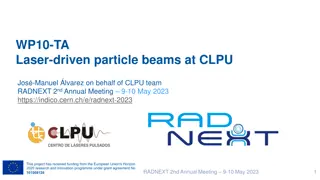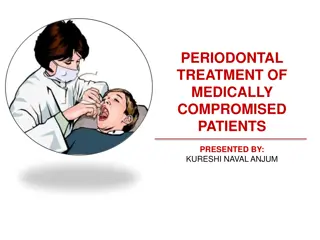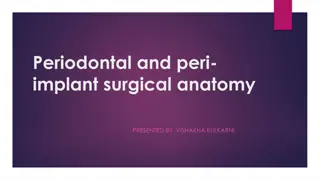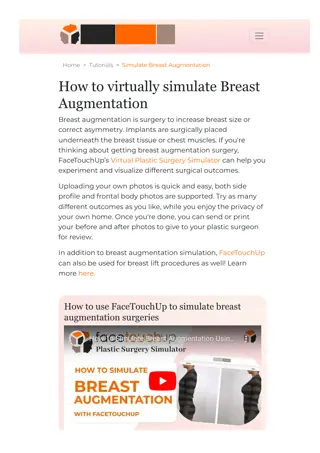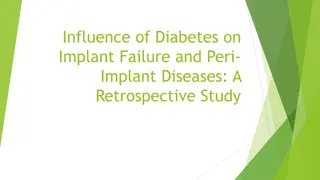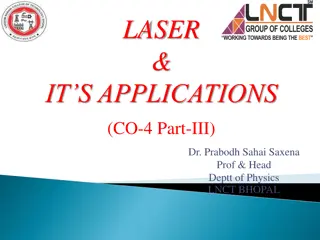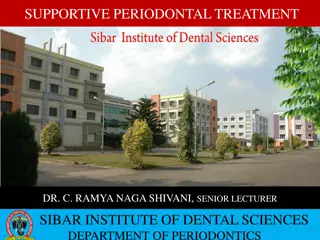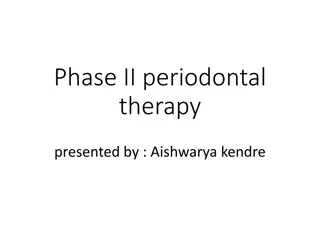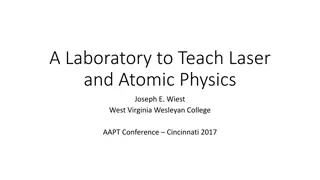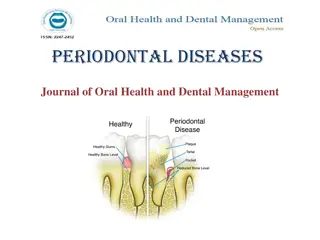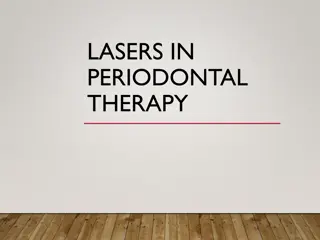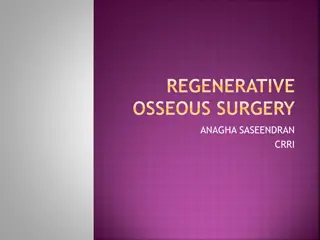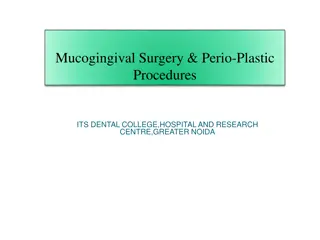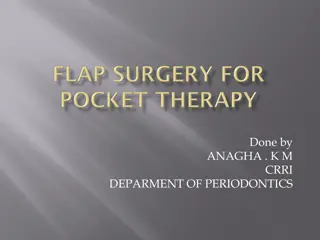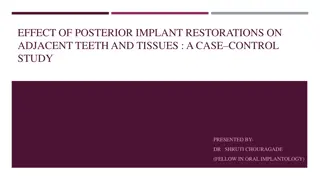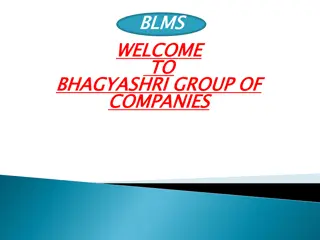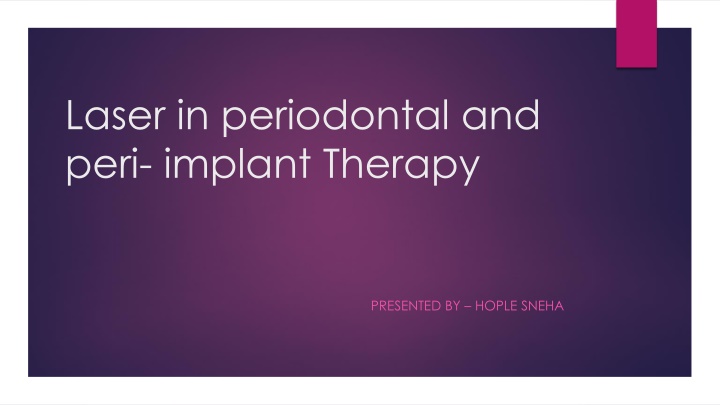
Laser Therapy in Periodontal and Peri-implant Treatment
Discover the different types of lasers in dentistry, their effects on tissues, classification based on application and energy emission levels, and the various laser beam delivery systems utilized in periodontal and peri-implant therapy. Learn about the safety measures associated with using lasers in dental practice.
Download Presentation

Please find below an Image/Link to download the presentation.
The content on the website is provided AS IS for your information and personal use only. It may not be sold, licensed, or shared on other websites without obtaining consent from the author. If you encounter any issues during the download, it is possible that the publisher has removed the file from their server.
You are allowed to download the files provided on this website for personal or commercial use, subject to the condition that they are used lawfully. All files are the property of their respective owners.
The content on the website is provided AS IS for your information and personal use only. It may not be sold, licensed, or shared on other websites without obtaining consent from the author.
E N D
Presentation Transcript
Laser in periodontal and peri- implant Therapy PRESENTED BY HOPLE SNEHA
Content: Introduction Classification of Lasers Laser Delivery Systems & Emission Modes Laser Interaction With Tissues Laser effects on Tissues Common dental Lasers Advantages & Disadvantages of Laser Lasers Safety in Dental Practice
Introduction: LASER is an acronym for light amplification by stimulated emission of radiation, is a form of electromagnetic energy in which photons are generated from a medium by stimulating the medium from external energy source. The intraoral use of lasers has evolved over the last 4 decades as clinical experience along with scientific investigation, has increased the body of knowledge. The dental lasers of today have benefited from decades of laser research and have their basis in certain theories from the field of quantum mechanics, initially formulated during the early 1900s by Danish physicist Bohr.
Classification of Laser: I. Based on application Soft tissue laser eg: Argon, Co2, diode; Nd:YAG. Hard tissue laser eg: Er:YAG Resin curing laser eg: Argon II. Mode of action Contact mode (focused or defocused) eg: Ho: YAG; Nd:YAG Non-contact mode (focused or defocused) eg: CO2
III. Based on Level of energy emission: Soft lasers (low level energy): Athermal low energy lasers emitted at wave length, which are supposed to stimulate cellular activity. Example: He-Neon; Ga-Arsenide. Hard lasers (High level energy): Thermal lasers emitted at wavelength in the visible infra red and U.V range. Example: Er:YAG laser; Nd: YAG laser. IV. Based on radiant energy generation: Continuous wave or continuous form (CW) Discreet or single pulses Multiple timed pulses (Pulse modes)
Laser beam Delivery Systems: Mainly two types: 1.Hollow tube waveguide It is hollow tube lined with series of well aligned mirror which reflect the laser beam from the unit of the handpiece- CO2, Er:YAG 2.Fibro optic Quartz silica fibers with a handpiece- Diode, Nd:YAG. This come in various diameters, the operator can select the diameter (range from 200 microm to 800 microm) as per the use
Emission Modes: Laser device can emit the light energy in one of 3 basic modes: 1.Continuous wave: the beam is emitted at one power level continuously as long as the device is activated by pressing the foot switch. 2.Gated pulse mode: there are periodic alterations of the laser energy being on and off, similar to a blinking light. This mode is achieved by the opening and closing of a mechanical shutter in front of the beam path of a continuous wave emission. 3.Free running pulsed mode. This mode is unique in that large peak energies of laser light are emitted for an extremely short time span, usually in micro seconds, followed by a relatively long time in which the laser is off.
Laser interaction with tissues: Laser energy can be transmitted or absorbed based on the composition of the target tissue
Absorption: Absorption of the laser light by the target tissue is the primary and beneficial effect of laser energy. When absorbed, light energy is converted into thermal energy.
Laser Effects On Tissues: The light energy from a laser can have four different interactions with the target tissue. Photo thermal interaction. Photo chemical interaction. Photo mechanical interaction. Photo electrical interaction.
Photo Thermal Interaction: The principle effect of laser energy is photo thermal i.e. conversion of light energy into heat. Light energy~Heat energy Photo ablation-, or the removal of tissue by vaporization and superheating of tissue fluids. Type of thermal reaction depends on the -- Spot size Power density Optical properties and composition of irradiated tissue
Effects on tissues on certain temperature:
Photo Chemical interaction: There are photochemical effects from the laser light that can stimulate chemical reactions (e.g. the curing of composite resin) and breaking of chemical bonds (e.g. using photosensitized drugs exposed to laser light to destroy tumor cells, a process called photodynamic therapy).
Photo mechanical interaction: Photo-disruption-shock waves by laser-rupture the intermolecular and atomic bonds. Photo-disassociation which is the breaking apart of structures. Photo-acoustic interactions- Removal of the tissue with Shockwave therapy.
Photo electrical interaction: Photo plasmolysis, tissue is removed through the formation of electrically charged ions.
Common dental Lasers: 1.Co2 laser: 10,600 nm Both pulsed and continuous wave Readily absorbed by water- very effective for soft tissue surgery Advantage over Scalpel- strong hemostatic and bacterocidal effects
When applied to hard tissues produces severe thermal damage, such ascracking melting, and Carbonization(Sasaki et al 2002) So its use has been limited to soft tissue surgery
2.Nd:YAG laser Free-running pulsed wave laser. wavelength of 1,064 nm. Low absorption in water. Energy scatters or penetrates to the biological tissue. its photo thermal effect is useful for soft tissue surgery. Produce relatively thick coagulation layer.
Has been widely accepted in soft tissue surgery. 1990- FDA approved for soft tissue surgery. Easy to deliver by optical fiber contact tip. Easy insertion into the pockets. 1997- FDA approved for sulcular debridemnt, first approval of laser application in periodontal pocket by FDA Not suitable for hard tissue ablation.
3. Er:YAG laser Solid-state laser that generates a light with a wavelength of 2,940 nm Since the Er:YAG laser is well absorbed by all biological tissues that contain water molecules, this laser is indicated for both soft and hard tissue ablation
The free-running pulsed Er:YAG laser has already been used clinically for caries. removal and cavity preparation. 1997- FDA approved for hard tissue treatment such as caries removal and cavity preparation
Advantages: Cut and coagulate precisely, in one step Eliminate collateral tissue damage Minimize post-operative inflammation and discomfort Clean, bloodless operating field Radiant coagulation: seal blood vessels without cauterization via conductive heat or carbonization Lasers seal lymphatic vessels thus leading to less postoperative swellling Greater comfort during and after surgery. Homeostasis and reduced risk of blood borne pathogen Rarely needs suture High patient acceptance of treatment.
Controlled depth of laser penetration Hemostasis provides excellent visibility-even down in thpocket Reduce patient discomfort and the need for anesthetic Laser incisions heal faster than electro-cautery
Disadvantages: Retinal burn if no protection Prolonged exposure to pulp causes irreversible pulp damage. High cost. Specially trained personnel required.- Chances of explosion. Aerosol contamination- respiratory hazards.
Laser safety in Dental pratice: 1. Eye: Acute exposure of the eye to lasers of certain wavelengths and power can cause corneal or retinal burns (or both). Chronic exposure to excessive levels may cause corneal or lenticular opacities (cataracts). 2 Skin: Acute exposure to high levels of optical radiation may cause skin burns; while carcinogenesis may occur for ultraviolet wavelengths (290-320 nm). 3.Chemical: Some lasers require hazardous or toxic substances to operate (i.e., chemical dye, Excimer lasers). 4. Electrical: Most lasers utilize high voltages that can belethal 5. Fire: The solvents used in dye lasers are flammable. High voltage pulse or flash lamps may cause ignition.

